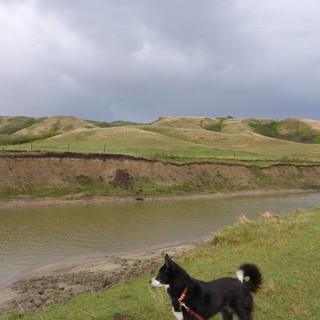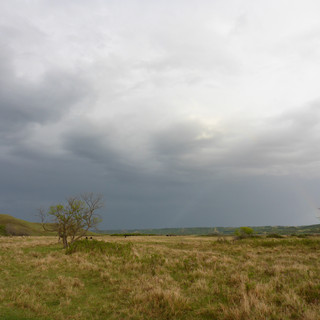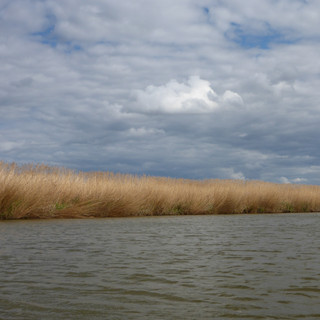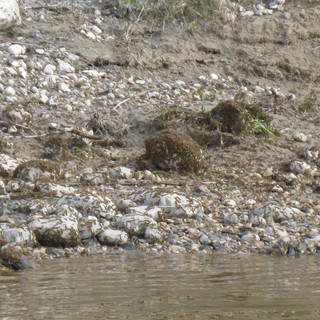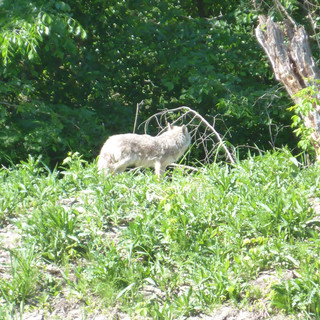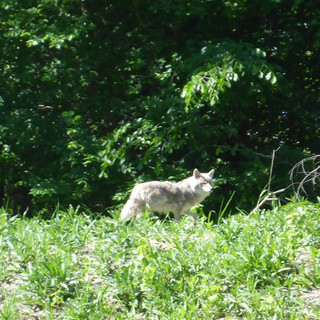Sunday, May 21 to Wednesday, June 7, 2017 - Fort Qu'Appelle (SK) to Brandon (MB)
Do you know the expressions "It’s a small world" and "Never two without three"? Well, these two expressions proved true once again. We met Jill for a third time in a year. We first met her at Sturgeon Landing in Saskatchewan last year, then at the Loreburn School a few weeks ago and then here in Fort Qu’Appelle. She was surprised to see us. She came to visit us at the campground, accompanied by her husband. Thanks to Jill, we were able to meet her father, Jerry, who took the time to show us the fish farm hatchery for which he worked for more than 37 years. He also showed us his cedar canoes (real works of art, made by himself). At the fish farm in Fort Qu'Appelle, there are three types of trout: rainbow, brook and tiger. There is also walleye. This fish farm produces juvenile fry for all of Saskatchewan. The whole process was explained (there are many stages and things to consider before releasing the fry). The farm annually produces half a million trout and twenty million walleye. For more details or to plan a visit: http://www.tourismsaskatchewan.com/site-info/all-listings-and-packages/103146/fort-qu'appelle-fish-culture-station
Jerry also showed us a very special trophy. It is for the annual Echo Lake Road Race. This 20 kilometre race has been in existence since 1925. All the names of the winners are engraved on the plates located around the base of the cup. An important piece of history for the region. In 1977 the event was taken over by the Lions Club. Jerry is the president of this race.
On Monday, May 22, we left Fort Qu'Appelle. After paddling on the two lakes following Fort Qu'Appelle and passing Lebret and Katepwa Beach, we arrived at a dam. We had to portage. There were many people fishing near the dyke and the migratory pass. Despite the "No Fishing" signs, people caught large pike, either by hand, by bow or with a fishing rod.
Putting the canoe back into the water was not as pleasant as it was on other occasions. The little water there was, was brackish. The mud smelled really bad and we had to walk in the river a long time before we found enough water to get back into the canoe (but not enough water to paddle with a full blade).
The next day, we walked more than we paddled. We scraped bottom. Fortunately, the river bed was generally made up of mud or sand, but there was also gravel and rocks in places. If it was not the lack of water that slowed us down, it was the barbed wire or the cows with their calves crossing the river.
That day, we were thrilled to see a lot of coyotes and even one swimming. We saw a raccoon looking for mussels and a beaver rolling on his back on the bank. The river attracts wildlife and wildlife makes the river very dynamic. Jasmine could not hold back any longer. Her primitive instincts propelled her out of the canoe! She was in the water and swam to go hunting. The call of the beavers was stronger than the strength of her mind. She cracked! That was just the beginning. Twice she jumped out of the canoe and swam to the shore. It was now a game she played until we arrived in Brandon, Manitoba. Fortunately she never caught any animals.
On Wednesday, we decided to remain in the same place. Gusts exceeded 70 km/h so there was no point in trying to advance. We camped at the edge of a field where cows came to graze. They did not come too close, except during the night. During our resting day, we took the time to observe nature. We were able to determine that coyotes and cows cohabit well together.
On Thursday, May 25th, we started thinking about options, because of my knee injury. There are a lot of portages coming up on our course and unfortunately I do not think I can make long portages. We have an alternative route for much of Ontario in mind to avoid portages on the French River, North Bay, Mattawa and the Ottawa River, but, there is a long portage coming, the one that crosses over to Grand Portage (Minnesota) on Lake Superior. It is this portage that worries us. We still have time in front of us, but we have to start thinking about it seriously.
Friday was a day of patience and effort. We made an impressive number of turns that seemed endless. We could not wait to get to Crooked Lake! Fortunately, the closer we got to the lake, the more depth there was under the canoe. So less walking, and more paddling. At the entrance to the lake, however, we had to scoot in bottomless mud, so that we could reach the open water of the lake. We stopped at the end of the day at the provincial park. We were able to have a warm shower.
From Saturday, May 27 to Wednesday, May 31, we went through the last section of the Qu'Appelle River. We must say that this was our favourite section. There was more depth, the water seemed cleaner and there were fewer cows coming to the water's edge. We saw turtles, raccoons, beavers, muskrats, mink, otters, deer, elk, moose, fish, owls (great horned owl), royal and bald eagles, hawks, great herons, goose, ducks and teals, plovers and an array of birds of all kinds. We were able to camp on sand two nights ... yes, sand! There were also episodes of rain and we even had to cut short a day due to a thunderstorm.
After Round Lake, the scenery began to change again. There were cliffs and it was a little bit more hilly. The smells were different. Then we found another sandbank, making the camp setup extremely easy and comfortable. Emptying the canoe was a fun game.
On May 29, we achieved our biggest day certainly on the Qu'Appelle River. It was already windy in the early morning (from the north) and there was a little more current. We passed two falls and several small rapids. It was hard on the canoe, but we covered ground and made a stopover at Tantallon (SK). The bridge under which we had stopped is the one for the main road. It was erected in 1930. The roads are dirt and everything is centralized in the same place (grocery, post, gasoline). The buildings were aging, as were the cars. It was like a small step back in time, but like everywhere, people were friendly.
On our map, we saw several French names around us. It would be necessary to review the history of the region to give an explanation for all of these names. They probably appeared due to the fur trade and voyageurs.
Then, we passed near the Fort Espérance Historic Site, near Rocanville, Saskatchewan. It was once a trading post of the North West Company. It was erected in 1787 and was abandoned in 1819. The place has been moved three times during its history. Located nearby, there was a trading post of the XY Company between 1801-1805 and another trading post of the Hudson's Bay Company between 1813-1816. At that time, the area was full of buffalo, an important ingredient for the pemmican, which was transferred to Fort Bas de la Rivière at the mouth of the Winnipeg River.
On May 30 and 31, we saw something quite impressive and disgusting. We saw billions of caterpillars in the water, on the ground, rocks, trees, branches, ... in fact on everything on which the caterpillars could climb on the land and the water! You could not even see the branches and the rocks! They were completely covered with these creatures. We learned later that these caterpillars attack the trees and this is why there are so many dead trees along the river, but also in the hills overlooking the valley. We had to choose wisely our location to set up camp in order to avoid the caterpillar infestation. We have read that this year is the most prolific year for these insects, the forest tent caterpillars. Here's a CBC report on it, posted on June 2 from St. Lazare, the junction of the Qu’Appelle and the Assiniboine River): http://www.cbc.ca/news/canada/manitoba/st-lazare-manitoba-caterpillars-1.4141301
Finally, on May 31st at 3:33 am local time, we left the Qu'Appelle River and entered the Assiniboine River (Manitoba). Our first observations were that the river was clearer (we could see our paddles), faster, wider and above, there were more beautiful places to stop (long sandbanks).
On Wednesday, May 31, we saw a superb elk. He already had a large velvety rack of antlers. We managed to film it a long time before Jasmine began to bark. Unfortunately, no picture to show you, but a film that will be available later.
The next day and the first day of June, we had a strong wind from the south and south-east. It refreshed us, as it was hot. It was the first day we traded our neoprene boots during the day for our Crocs. The landscape changed gradually. There were more trees on the bank and in the river. There was less current too. We stopped at 6:00 pm at a place where a seasonal bridge was placed allowing people to use a shortcut to get to Miniota (MB). The water was just beneath the bridge. We made a portage. On this bridge we met Caroline and her daughter Brooke who filled one of our 10 litre water bags and brought us fresh sweet peas and homemade small balls of energies (soooo delicious). A perfect snack to reward our 81 km done on the river during the day. The generosity and kindness of Manitobans does not change. Welcome to Manitoba!
Friday, June 2 was a short day because of a storm in the afternoon. There were not many options to stop and the one we took led us to the edge of a farmer's field. It is always peculiar to sleep near a field. As the darkness settled gradually, the animals came out of the trees and walked freely in the field. We saw three elk among others. We could see them from inside our tent.
On June 3, we took advantage of a wind from the west gusting at 65 km/h. We had a headwind about a third of the day (due to the curves of the river), and the rest of the day, the wind helped us. So we traveled more than 75 km on the river. The day was very hot and we drank more than our normal daily rations. We started to think about our water consumption and to plan meals that required less water. We still had 100 km of river to go before we reached Brandon, and we were not sure we could find a less silty stream to take water from.
Finally, we found a potential stream the next day around 10:00 am. We filled a 10 litre bladder and continued our day. The scenery was beautiful! In some places, we could see the green grasses of large fields cutting from the yellow of the cultivated fields. We went from a wooded area to the plain. The fauna was still as abundant and diversified. Around 5 pm, we found a place to stop and set up our tent. The places were very scarce and the sandbanks were now non-existent. Barefoot in the mud, I emptied the canoe while Pierre carried the bags over the top of the mound. It was funny to feel the mud ooze between my toes. I was in mud up to my calves. Then we tried to quench our thirst, from a very hot day. It was not until 11:00 pm that the temperature dropped.
On Monday, June 5th, we were already sitting in the canoe, paddles in our hands, at 6:30 am. We wanted to take advantage of the cool morning to move on. We had 55 km to cover to get to Brandon, with an east wind. We saw the sun rise as we packed up camp. The sun was bright orange and its rays timidly came to us through a row of trees dividing two fields.
Since our arrival on the Assiniboine, we have found relics and vestiges of the flood of 2011. Trees are still caught under the bridge decks and in some places in the outside curves, there are piles of branches and dead trees. As we approached the Highway 1 (the Trans-Canada Highway) bridge, the current resumed. We saw the return of sand and gravel beaches and they multiplied as we approached Brandon. We finally stopped at Turtle Crossing Campground in Brandon. We were welcomed by Mark (owner) who allowed us to go to the grocery store the night we arrived. The next day, we had to rent a car from Enterprise. We received a nice gift, as we did not have to pay for the gas. Thank you to all those people who help us continue our adventure!






































